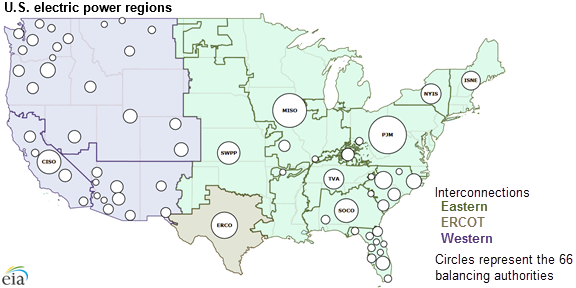The Electric Reliability Council of Texas (ERCOT) is a balancing authority that manages 90% of the power that flows through Texas's electric grid. It's a nonprofit organization whose main goal is to facilitate the reliable transfer of electricity throughout the state.
There are many other balancing authorities throughout the US, but ERCOT is unique. It's the only balancing authority that's also an interconnection, that's not subject to federal oversight and that has to manage Texas's Energy Choice market on top of the electric grid.
What Does ERCOT Do?
ERCOT does many things, but all in the service of two primary objectives:
- Maintain electric system reliability
- Facilitate a competitive electric market
How ERCOT Maintains System Reliability
First and foremost, ERCOT is a balancing authority, which means it manages the electric grid to ensure the system runs reliably. In simple terms, balancing authorities do this by balancing electricity demand with electricity supply.
All electric grids require a balance between the amount of electricity generatedsupplywith the amount of electricity consumeddemand. If one outweighs the other, it can result in a massive blackout across the system that could take weeks, or months, to repair.
The main problem balancing authorities face is too much electricity demand. This is when electricity consumers are using more power than electric generators can create. To fight this, balancing authorities will use a range of methods, from spinning up peaker plants to implementing demand response programs.
If none of these methods work, then these authorities will implement rolling blackouts. In this situation, power is cut off to certain sections of the grid to lower electricity demand. These outages will be rotated around the grid until supply can catch up with demand.
Rolling blackouts are actually what ERCOT implemented during Winter Storm Uri in February 2021.
How ERCOT Facilitates a Competitive Electric Market
Texas has a unique electricity market where many residents and businesses have the power to choose their electricity providers. ERCOT's role in this market is to ensure it remains competitive so wholesale electricity prices stay low.
It does this in a few ways.
- It manages the transactions between electricity providers and power generators
- It sets rules and regulations to ensure those transactions run smoothly
- It ensures equal access to the grid so no one entity can stifle out the competition
Why The ERCOT Interconnection Is Unique
In the US, there are three interconnections that operate independently from one another:
- The Eastern Interconnection
- The Western Interconnection
- The ERCOT Interconnection
In the image below, you can see these three interconnections. Within those interconnections, there are balancing authorities that manage the flow of electricity within their respective zones.

However, as you can see from the map, ERCOT is unique in that it's its own balancing authority and interconnection. On top of that, it's the only interconnection that lies solely in one state.
Since ERCOT is its own interconnection that lies solely in the state of Texas, ERCOT does not transfer much power in or outside of the state. This is why ERCOT is not subject to federal oversight like other interconnections and balancing authorities in the US.
Who Runs ERCOT?
ERCOT is governed by a board of directors. In the past, board members were selected by a committee of its current members. Many of these representatives were from Texas utility companies, power generators, power marketers, electricity providers and electricity consumers. However, much of this changed after the passing of Senate Bill 2 at the beginning of June 2021.
Today, the size of the board has shrunk from 16 to 11 members. Eight of these members are now appointed by a selection committee. This committee consists of three individuals, one selected by the governor, one by the lieutenant governor and one by the speaker of the house.
ERCOT is still overseen by the Public Utility Commission of Texas (PUCT), which is the state regulatory agency that manages utilities in the state.
How is ERCOT Funded?
As of April 2021, ERCOT states that it is funded by a System Administration Fee of 55.5 per megawatt-hour (MWh). For most Texans, this means around .4% or $.50-$.60 of your bill is going to fund ERCOT every month.
It's important to note that ERCOT does not dictate these prices. The PUCT sets electricity prices for ERCOT and other utility providers in the state.
- What does ERCOT stand for?
-
ERCOT stands for the Electric Reliability Council of Texas. It’s the nonprofit entity that manages most of Texas’s electric grid.
- Who owns ERCOT?
-
Nobody really owns ERCOT. It is an independent organization that was created back in 1970 to ensure a more stable grid in Texas. It’s run by a board of directors and is overseen by the Public Utilities Commission of Texas (PUCT).
- Is all of Texas under ERCOT?
-
No. ERCOT manages around 90% of all the electricity in the state, but there are still parts of Texas in the jurisdiction of balancing authorities outside the state.
- Does ERCOT sell electricity?
-
ERCOT does not sell electricity. Residents and businesses get their electricity from retail electricity providers in Texas.
- Does ERCOT own any electric infrastructure?
-
ERCOT does not own any electric infrastructure. Texas utility companies own and maintain transmission lines and equipment.